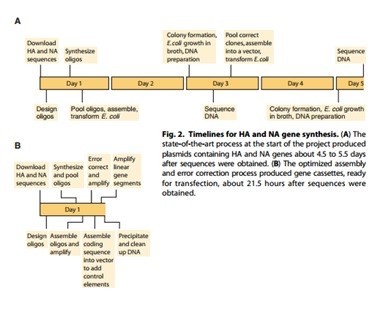FA16 Immunization Module’s Updates
A quick, effective response via Synthetic Vaccine Production
In light of viral epidemics that have blown up in the past few years, the incentive to create a quick, effective countermeasure for these outbreaks has grown. Synthetic viruses have thus begun to garner some well-deserved attention due to the benefits they promise. In the field of synthetic biology, the company Novartis has realized this and has developed a method to rapidly respond and produce vaccines against viral outbreaks.
In Novartis’s goals for quick response, the time it took to physically transport viral samples, isolate viral genetic sequences, and traditionally reproduce the virus in chicken eggs created the risk of missing epidemic spikes. Further, in a previous attempt to use novel technology for vaccine production, their product was rejected for failure to sufficiently produce large amounts of accurate viral antigenetic sequences. [1,2]
In Novartis’s quicker method for vaccine production, an cell-less enzyme system was used to massively and quickly reproduce viral gene sequence in less than a day as opposed to the traditional 4.5 to 5.5 days. Already down by 4 days in preparing genetic information for transfection and mass production, Novartis further used a common genomic backbone to increase the retrieval of usable, accurate genomic sequences for vaccine production. [2]
In a simulation of a bird flu (H7N9) outbreak, Novartis researchers downloaded genomic data from a clinical specimen and reproduced a viral genome via a cell-less, enzymatic process. Within 1 week, the team had also started to produce viruses through cell culture. The goal in this methodology and simulation was to show that other companies could effectively use electronic data from a single genomic analysis and quickly produce vaccine candidates in as little as a week as opposed to several months. Assays and productions would then be the only confounding factors and the response time to a viral outbreak would be effectively shortened. [2]
1. Young, S. (2013, May 14). Synthetic Biology Could Speed Up Flu Vaccine Production. MIT Technology Review; https://www.technologyreview.com/s/514661/synthetic-biology-could-speed-flu-vaccine-production/
2. Dormitzer et al. Sci Transl Med 5, 185ra68 (2013); http://www.tolonenlab.org/Presentations/MSSB/Exam2013/dormitzer2013.pdf



That's amazing Noah. It is really spectacular what bio-engineering is able to accomplish. I am curious how they test the antigens efficacy. Do they simply inoculate mice and then expose them to live virus? Or do they inoculate animals and then test how effectively serum antibodies bind to live virus? Probably beyond the scope of this review, but I am curious.
Undoubtedly genome technology has had a big impact on our ability to identify pathogens and follow them during epidemics. This post nicely highlights the use of this technology to produce that potential antigens. Unfortunately, we don't have a good understanding of which of these might work better than others and there are still many hurdles for generating vaccines to new pathogens/strains that are both safe and effective.
Really cool update, Noah. I was just reading about the original cowpox inoculation practices of the 18th century, and it's quite something to contrast that to the cutting edge of vaccination technology of our present day.